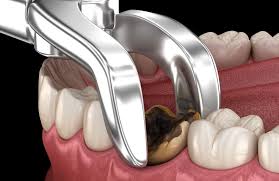
Tooth Extraction:
Tooth extraction, the process of removing a tooth from its socket in the bone, is a common dental procedure. It may be necessary for a variety of reasons, including severe tooth decay, gum disease, impacted teeth, or overcrowding. While the idea of tooth extraction can be intimidating, knowing what to expect before, during, and after the procedure can help ease any concerns and ensure a smooth recovery. This article provides a comprehensive overview of tooth extraction and what you can expect at every stage.
You Might Also Interested In: WooCommerce SEO Agency
1. Why Tooth Extraction May Be Necessary
Tooth extractions are typically performed when a tooth is beyond repair, or its removal will improve your overall oral health. Here are some common reasons why a dentist might recommend tooth extraction:
- Severe Tooth Decay or Damage: When a tooth is too badly damaged from decay or trauma to be restored with a filling, crown, or root canal, extraction may be the only option.
- Gum Disease: Advanced periodontal disease can cause teeth to become loose or unstable, requiring extraction.
- Impacted Wisdom Teeth: Wisdom teeth, or third molars, often become impacted (trapped in the jawbone or gums) and can cause pain, infection, or misalignment of other teeth, making extraction necessary.
- Overcrowding: In some cases, teeth may need to be removed to create space in the mouth before orthodontic treatment (such as braces).
- Infection: If a tooth infection cannot be treated with antibiotics or root canal therapy, extraction may be needed to prevent the spread of infection.
2. Types of Tooth Extractions
There are two types of tooth extractions: simple and surgical.
- Simple Extraction: This procedure is performed on a tooth that is visible in the mouth. The dentist uses an instrument called an elevator to loosen the tooth, and then it is removed with forceps. Simple extractions are typically quick and done under local anesthesia.
- Surgical Extraction: A surgical extraction is more complex and involves removing a tooth that is not fully visible or has not yet erupted (e.g., impacted wisdom teeth). In these cases, the dentist or oral surgeon may need to make an incision in the gum tissue and may need to remove bone around the tooth. Surgical extractions may require general or local anesthesia with sedation.
3. Preparation for Tooth Extraction
Before the extraction, your dentist will perform a thorough examination, which may include X-rays to evaluate the position of the tooth and surrounding bone. This helps the dentist plan the extraction procedure and anticipate any potential complications.
If you have a medical condition such as diabetes, heart disease, or a weakened immune system, be sure to inform your dentist. Additionally, let your dentist know if you are taking any medications, especially blood thinners, as they may need to adjust your medication schedule to prevent excessive bleeding during the procedure.
On the day of the extraction:
- Follow your dentist’s instructions regarding eating or drinking beforehand, especially if sedation will be used.
- Wear comfortable clothing and arrange for transportation home if you are receiving sedation or general anesthesia.
4. What to Expect During the Procedure
The steps of a tooth extraction procedure will vary depending on whether it’s a simple or surgical extraction.
Simple Extraction:
- Numbing the Area: The dentist will apply a local anesthetic to numb the tooth, gum, and surrounding bone tissue. You’ll feel pressure but no pain during the procedure.
- Loosening the Tooth: Using a special instrument called an elevator, the dentist will carefully rock the tooth back and forth to loosen it from the socket.
- Removing the Tooth: Once loosened, the dentist will use forceps to remove the tooth. You may feel some pressure but not pain.
Surgical Extraction:
- Anesthesia: Depending on the complexity of the procedure, you may receive local anesthesia with sedation or general anesthesia to keep you comfortable during the surgery.
- Incision: If necessary, the dentist or oral surgeon will make an incision in the gum to access the tooth. In some cases, they may also need to remove some bone tissue around the tooth.
- Tooth Removal: The dentist may section the tooth into smaller pieces to make it easier to remove.
- Closing the Incision: After the tooth is removed, the dentist may place stitches to close the gum tissue, especially in surgical extractions.
5. After the Extraction: What to Expect
Once the tooth is removed, your recovery process begins. Here’s what you can expect and how to care for yourself post-extraction.
Immediate Aftercare:
- Gauze: Your dentist will place gauze over the extraction site to control bleeding. You will need to bite down gently on the gauze for 30-45 minutes. Replace it if needed.
- Pain Management: As the anesthesia wears off, you may experience some discomfort. Over-the-counter pain relievers, such as ibuprofen, are typically sufficient for managing post-extraction pain. Your dentist may prescribe stronger pain medication if necessary.
- Ice Pack: Apply an ice pack to the outside of your cheek for 10-20 minutes at a time to reduce swelling.
Rest and Recovery:
- Rest: Take it easy for at least 24 hours after the extraction. Avoid physical exertion or heavy lifting, as it could increase bleeding or swelling.
- Avoid Smoking or Using Straws: Smoking or using a straw can dislodge the blood clot that forms in the socket, leading to a painful condition known as dry socket. It’s important to avoid these actions for at least 72 hours post-extraction.
- Stick to Soft Foods: For the first few days, stick to soft foods like yogurt, applesauce, mashed potatoes, and soups. Avoid chewing on the side of the extraction to prevent irritation.
Oral Hygiene:
- Avoid Brushing the Extraction Site: For the first 24 hours, avoid brushing or rinsing your mouth vigorously. After this period, you can begin gently rinsing with warm saltwater to help keep the area clean and reduce inflammation.
- Brush and Floss Carefully: Continue brushing and flossing your other teeth as normal, but be careful to avoid the extraction site.
6. Potential Complications
While most tooth extractions go smoothly, complications can occur. It’s important to monitor your recovery and watch for any signs of issues, such as:
- Dry Socket: This occurs when the blood clot that forms in the socket is dislodged or doesn’t form properly. Dry socket can cause severe pain and delay healing. If you experience intense pain a few days after the extraction, contact your dentist.
- Infection: Signs of infection include persistent pain, swelling, fever, or foul-tasting discharge from the extraction site.
- Excessive Bleeding: Some oozing is normal after extraction, but if bleeding persists for several hours or becomes heavy, contact your dentist.
7. Healing and Long-Term Care
Most people recover from a tooth extraction within a few days to a week. In the case of a more complex surgical extraction, recovery might take a little longer. Following your dentist’s aftercare instructions will ensure proper healing.
If the extracted tooth was removed for orthodontic reasons, your dentist will discuss the next steps in your treatment plan. If it was removed due to decay or infection, your dentist may talk to you about options for replacing the missing tooth, such as dental implants or bridges.
Conclusion
Tooth extraction may sound daunting, but with proper preparation, the procedure is generally straightforward and safe. Knowing what to expect during the process can help reduce anxiety and ensure a smooth recovery. Following your dentist’s aftercare instructions and maintaining good oral hygiene afterward are key to avoiding complications and promoting healing. If you have any concerns or experience unusual symptoms after the extraction, don’t hesitate to contact your dentist for advice.











